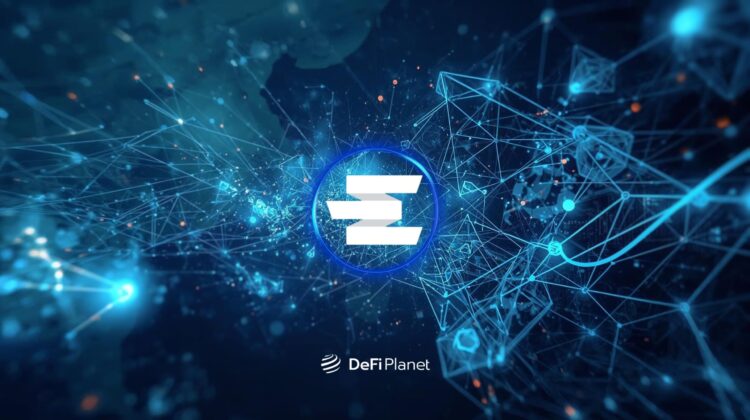DeFi lending in 2025 is more powerful than ever, but also more complex. Between fluctuating interest rates, scattered liquidity pools, and intimidating interfaces, many users still find the process overwhelming and risky. What the space needs is a platform that simplifies access without sacrificing performance or control.
That’s why Chester Bella and Danny Boahen introduced ETHA Lend. It promises a smarter, more approachable DeFi experience by offering fixed-term, collateralized credit products and automated yield strategies, all designed with everyday users in mind.
Let’s discuss how ETHA Lend works and whether it lives up to the promise of making DeFi lending truly accessible.
What Is ETHA Lend?
ETHA Lend is a DeFi protocol designed to simplify and optimize the lending and borrowing experience. The goal is to make yield generation and credit access more user-friendly, stable, and efficient, especially for users who are new to DeFi or overwhelmed by complex interfaces and volatile interest rates.
The platform is deployed on both Ethereum and Polygon, giving users the flexibility to choose between Ethereum’s security and Polygon’s low-cost, high-speed transactions. This multi-chain approach ensures that users can access ETHA Lend with minimal fees and delays, regardless of their preferred network.
Here are the key features:
- ETHA Token
The ETHA token is the platform’s utility token, used for governance (voting on protocol changes), staking for rewards, and liquidity mining.
- Trading market
ETHA Lend’s Trading Market acts as its core liquidity hub, allowing users to buy, sell, and swap supported assets with minimal friction. Integrated directly into the platform, it benefits from automated algorithms that route trades through optimal liquidity pools, ensuring competitive rates and reducing slippage.
- eVaults
eVaults are automated yield-generating vaults that allocate deposited assets across multiple DeFi protocols. Users simply deposit their tokens, and ETHA Lend’s algorithm distributes them strategically to maximize returns, with no need for manual adjustments. These vaults can rebalance in real-time to capture the best opportunities.
- Single-asset stake pools
For users seeking leveraged yield, Single-Asset Stake Pools allow you to stake one asset and earn enhanced rewards via leverage strategies built into the pool’s logic. This enables deeper farming potential on a single token, though it comes with increased complexity and risk mitigation measures in place.
- ETHA wallet
The ETHA Wallet is a non-custodial, interface-native wallet designed for seamless interaction with the platform. It supports atomic trades, enabling users to swap and stake tokens in a single transaction to optimize returns. The wallet integrates closely with ETHA Lend’s yield strategies, offering users one-click access to optimized positions.
How Does Ether Lend Work?
ETHA Lend operates on a decentralized, smart-contract-driven model that lets users lend and borrow assets without centralized intermediaries, handling everything automatically.
Lending
Users deposit crypto into ETHA Lend’s lending pools, which aggregate liquidity from multiple participants. These pooled funds are made available for borrowers.
Lenders earn interest based on usage and loan duration, payments that come directly from the borrower’s interest. Thanks to an intelligent yield optimization engine, deposited assets are allocated across different protocols to maximize overall returns.
Borrowing
To borrow, users lock up collateral, typically valued higher than the requested loan amount, to secure the debt. This overcollateralization model protects the protocol against price volatility. Borrowers can choose from fixed-term loans (with predictable repayment schedules) or flexible loans (which allow early repayment but may carry variable interest). Smart contracts enforce these terms clearly and automatically.
Interest rates
ETHA Lend uses a dynamic, algorithmic interest model that adjusts based on real-time supply and demand conditions within each liquidity pool. This ensures competitive and fair rates for both lenders and borrowers, and helps maintain healthy liquidity in the system.
Smart contract automation
All lending and borrowing processes, including collateral management, interest accrual, repayments, and liquidations, are executed by audited smart contracts. These contracts automate every step securely and transparently, eliminating the need for third-party intervention or manual oversight.
Yield Optimization Engine: Smarter Lending Returns
ETHA Lend’s Yield Optimization Engine dynamically allocates your deposits across DeFi protocols like Aave, Compound, and Curve to maximize returns.

Multi-protocol routing
When you deposit crypto assets, the engine analyzes yield opportunities across multiple protocols and routes funds accordingly. It supports Polygon-based lending and liquidity pools, selecting platforms offering higher returns, balancing safety and profitability.
Dynamic rebalancing
ETHA Lend’s portfolio rebalancing helps users maximize returns by automatically adjusting asset allocations across top DeFi protocols like Aave, Compound, and Curve.
Instead of relying on static strategies, ETHA Lend uses historical data and predictive analytics to forecast which platforms will offer better yields. As market conditions shift, due to changes in interest rates or token volatility, the system rebalances your portfolio accordingly.
Passive vs. Active strategy
With ETHA Lend, you can choose a fully passive “set-and-forget” model, trusting the engine to monitor and rebalance, or opt for a more active approach, rebalancing manually when you see fit. Either way, the system handles allocations and adjustments for you.
Security, Audits, and Risk Controls
ETHA Lend implements a security framework combining independent audits, smart contract safeguards, and risk management tools to protect users and maintain platform stability.
Smart contract audits & known vulnerabilities
ETHA Lend was independently audited by CertiK in April 2021, which found only informational and minor issues and confirmed that the protocol meets industry standards.
Real-time analysis by CertiK Skynet shows no current unresolved security vulnerabilities. A third-party security assessment by Cyberscope flagged some medium‑risk considerations related to decentralization and infrastructure, but no critical smart contract flaws.

Risk management: liquidation mechanisms & collateral tracking
ETHA Lend enforces over-collateralized borrowing thresholds and continuously monitors a health factor to assess loan safety. If collateral value drops near the protocol-defined liquidation threshold, bots or automated systems initiate liquidation to protect lenders’ funds. These mechanisms reduce systemic risk and uphold platform solvency.
Controls, bounties & reserves
While there’s no public record of a formal bug-bounty program or insurance reserve at this time, ETHA Lend’s architecture, built on audited smart contracts and over-collateralization, offers strong baseline protection. The protocol also incorporates a liquidity buffer in each lending pool, enabling smoother handling of liquidations and covering short-term funding needs to minimize risks during market stress.
Limitations and Challenges
While ETHA Lend brings innovation to DeFi lending, it still faces several hurdles that could impact its long-term adoption, user growth, and competitive edge.
1. Lower asset variety compared to Aave or Compound
ETHA Lend supports a curated set of assets, focusing on popular stablecoins and select volatile tokens. However, users looking to lend or borrow a broader range of digital assets, including long-tail or newer tokens, might find ETHA’s offerings limited.
Platforms like Aave and Compound provide significantly more asset options, giving users more flexibility and diversification opportunities.
2. Fixed-term lending may limit flexibility
Fixed-term lending can offer more predictable yields, but it’s not always ideal for users who need liquidity on short notice. Unlike flexible lending models, where users can withdraw funds anytime, ETHA’s time-bound structure means assets are locked for a set period, potentially creating frustration during sudden market shifts or emergencies.
3. Long-term sustainability of token rewards
ETHA Lend relies heavily on its native token ($ETHA) to incentivize participation, particularly for liquidity provision and staking. While this can attract users in the short term, long-term sustainability depends on real utility and demand.
Without ongoing innovation, strong tokenomics, or ecosystem expansion, reward dilution and user drop-off could become challenges.
4. Competition from other yield optimizers
ETHA Lend competes in a highly competitive segment of DeFi, going up against established players like Yearn Finance, Idle Finance, and Beefy. These platforms offer larger treasuries, wider integrations, and active communities. Unless ETHA Lend continues to differentiate with unique features, intuitive UX, or superior returns, it risks getting overshadowed.
5. Limited brand visibility and ecosystem partnerships
Despite its technical offerings, ETHA Lend has relatively low visibility in the DeFi space. It lacks high-profile partnerships or major integrations with Layer-2s, DAOs, or institutional players. This limited exposure could slow down user adoption and developer engagement unless supported by stronger marketing and ecosystem collaboration.
6. Smart contract dependency and centralization risks
Like many DeFi projects, ETHA Lend’s operations are powered by smart contracts. However, any bugs, exploits, or over-reliance on admin controls pose risks to user funds and trust. If a small team or multisig wallet governs upgradeability or critical protocol functions, this centralization could be a point of failure unless addressed through decentralized governance or audits.
Conclusion: Can ETHA Lend Compete in the Next DeFi Phase?
ETHA Lend has carved out a unique position in the DeFi space by simplifying lending and borrowing through automation, smart asset routing, and a user-friendly interface. Its focus on fixed-term credit products and yield optimization tools makes it especially appealing to users who value predictable returns without having to actively manage positions.
That said, ETHA Lend isn’t designed for everyone. Users looking for highly customizable lending terms, exotic assets, or maximum flexibility might prefer platforms like Aave or Compound. However, for those prioritizing efficiency, stable yields, and a less technical experience, ETHA Lend is a strong contender.
ETHA Lend combines smart automation with a clean user experience, making it a solid choice for everyday DeFi users. If the team continues to innovate, expand asset support, and attract more integrations, ETHA Lend could grow into a major player in the next generation of DeFi credit protocols.
Disclaimer: This article is intended solely for informational purposes and should not be considered trading or investment advice. Nothing herein should be construed as financial, legal, or tax advice. Trading or investing in cryptocurrencies carries a considerable risk of financial loss. Always conduct due diligence.
If you would like to read more articles like this, visit DeFi Planet and follow us on Twitter, LinkedIn, Facebook, Instagram, and CoinMarketCap Community.
Take control of your crypto portfolio with MARKETS PRO, DeFi Planet’s suite of analytics tools.”





















